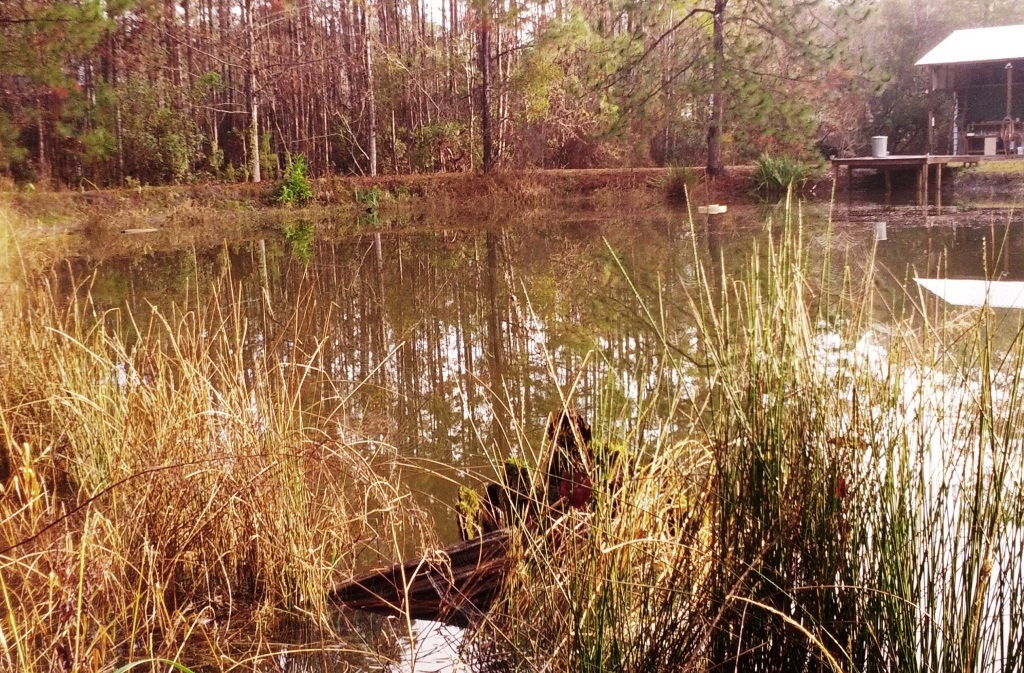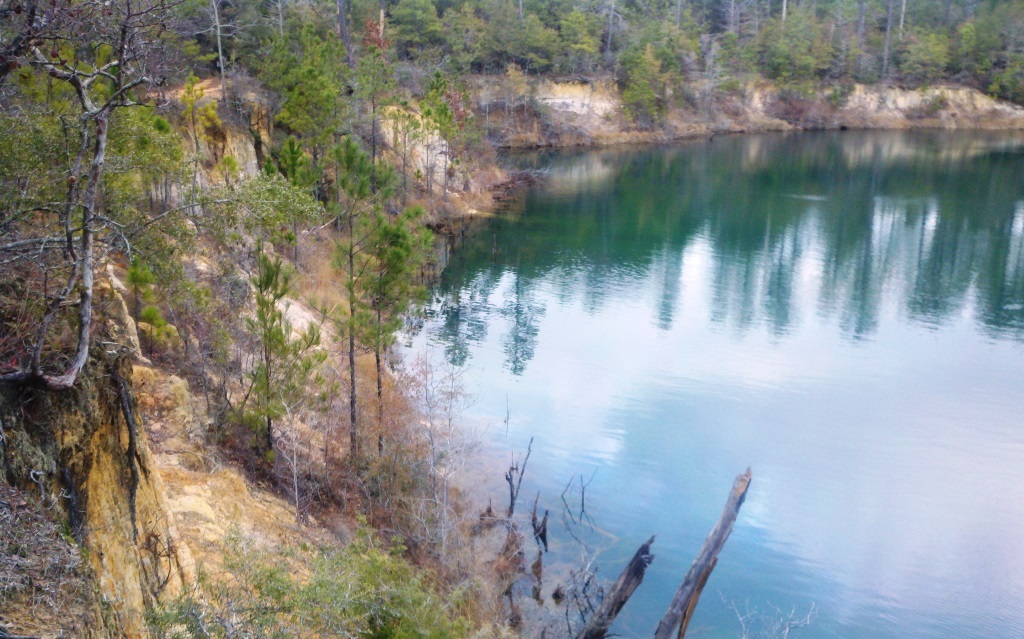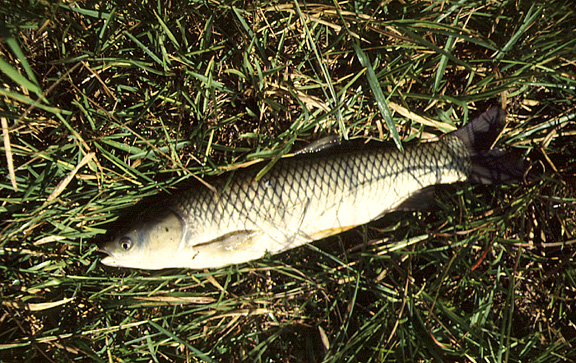
Your pond is dormant, but now is a good time to think about next year’s management activities. Photo by Judy Ludlow
During these icy, north Florida winters, you’re probably not thinking much about what needs to be done in your pond! Aquatic plants have become mostly dormant, fish feeding has slowed down, and irrigation needs are usually reduced as well. If you’ve had aquatic weed problems in the past though, now is a great time to do some pre-emptive planning for managing them before their likely return in a few months. This article is intended to provide an overview of aquatic plant management with a number of links to resources to help identify common aquatic plants, and provide information on management techniques, including the use of aquatic herbicides and grass carp. It will also list a few cold-weather pond-management actions to consider implementing.
North Florida’s fish and farm ponds play an important role in many aspects of agricultural life, from irrigation and recreation, to food production. Each of these uses determines what types of management techniques you can use to maintain the pond’s efficiency.
As you, no doubt, have observed, your pond is a dynamic ecosystem which is, literally, influenced from the ground up! Much of the water-body’s basic chemical and physical characteristics reflect the characteristics of underlying soils (sand, clay, organic, etc.) and major sources of water (ground water, rainfall, runoff, etc.). These then, in turn, influence the populations of plants and animals that inhabit the pond.

The soils underlying this north Florida pond determine much of its chemical and biological characteristics. Photo by Judy Ludlow
So, with this bigger picture in mind, let’s look at managing aquatic plants. There are hundreds of aquatic plant species in Florida, most are native, but some are not. The non-native aquatic plants are the ones that tend to cause many costly weed-related problems, although in smaller systems like farm ponds, some of Florida’s native aquatic plants can also cause problems that require management. An aquatic plant that has become weedy often causes problems for navigation, irrigation, water flow, fishing and recreational activities.
Aquatic plants provide many important functions in Florida’s waters. Below is a list of the major aquatic plant growth-types and how they can affect your pond or favorite Florida water body. (This list is taken from the following UF/IFAS website: Aquatic and Wetland Plants in Florida)
Submersed Plants (plants growing completely under water, like eelgrass):
- provide habitat for fish and wildlife
- affect nutrient cycles
- increase water clarity
- stabilize shorelines and sediments
- increase or decrease dissolved oxygen concentrations, depending on abundance and the availability of light
- contribute to muck accumulation
Emersed Plants (plants rooted underwater but growing through and above the water surface, like cattails or maidencane)
- provide food (seeds and leaves) for waterfowl
- provide habitat for wildlife
- reduce shoreline erosion
- shed leaves and other plant debris, adding to the sediments.
- Uprooted plants can form floating islands or tussocks that can pose significant navigational hazards and block access to portions of the waterbody.
- Tussocks also provide bird and wildlife habitat.
Floating Plants (plants rooted underwater or with free floating roots, with leaves floating on the water surface, like water lily or duckweed)
- Floating-leaved plant debris contributes to sediment, making a waterbody shallower.
- provide food and habitat for wildlife
- If periods of low water are followed by a rapid rise in water level, the roots of dead floating-leaved plants (called rhizomes) can float to the surface, block access, and hinder navigation. In many cases, masses of floating rhizomes (especially from the native plant spatterdock, Nuphar advena) can form floating islands that grow large enough to support trees.
- Water hyacinth and water lettuce may completely cover the surface of a waterbody and cause major problems for fish and wildlife habitat, recreation, navigation, and flood control.
- Floating and floating-leaved plants are not generally considered a human health concern, but they provide breeding habitat for mosquitoes.
- The stems of floating-leaved plants (spatterdock) often contain burrowing insects called bonnet worms that some anglers use for bait.
As you can see, aquatic plants can be an integral part of your pond’s stability. Keeping or introducing native plants in your pond is important for a number of reasons. Sometimes, however, plant control is necessary, to preserve the function of the water body. What are your first steps towards controlling aquatic weeds? Identify your problem plant and identify the use(s) of the pond.

Native aquatic plants, such as this bulrush provide a number of benefits for your pond. Photo by John Rodgers FWC
Proper plant identification is crucial to success. Your local UF/IFAS Extension Agent can help you identify the weed as well as provide management recommendations. The other crucial step in forming a management strategy is to identify the objectives of the pond. Is it for recreation? Raising fish? Wildlife habitat? Crop irrigation? Ornamental features? Or any combination of these uses? Objectives are very important to define as certain management tools can only be used in certain situations.

Aquatic plants such as the non-native, invasive plant Hydrilla, can become extremely weedy causing numerous and costly problems. Photo by Jeff Schardt, FWC
Aquatic plant management tools include, mechanical (plant harvesters), chemical (aquatic herbicides), physical (drawdowns) and biological (grass carp) methods. The best approach to management is an integrated approach, combining as many of these tools as possible to control the target plant(s).

Grass carp eat aquatic plants and are an example of “biological control.” Photo courtesy of UF/IFAS Center for Aquatic and Invasive Plants.
In addition to thinking about aquatic plant management come springtime, here are a few general winter pond management considerations:
- Because low water temperature reduces fish activity as well as beneficial bacterial decomposition processes, reduce the amount of feed you provide your fish in the winter. Use the fish’s feeding behavior as your guide. Fish will generally slow feeding when water temperatures are at or below 60 degrees. Uneaten food will cause excess organic matter to accumulate increasing the chances of low oxygen levels and a fish kill.
- If you have an aerator, keep it operative during the winter, especially during warm spells and cloudy weather. It is probably not necessary during periods of strong, windy, cold fronts passing through our area, but watch your fish for signs of oxygen stress! If you don’t have an aerator and your pond is productive with a high number of fish, plants, and algae, consider installing one, especially as the weather turns warmer next summer.
- Remove dead shoreline plant material that may fall into the pond. Don’t throw the dead plants into the water. Doing so will increase the amount of organic material and increase the chances of oxygen depletion and a possible fish kill.
- Check condition of fish feed, pumps, aerators, and structures around the pond and maintain or replace as needed.·
There is a lot of information in this article, but remember, if you have questions, please contact your local UF/IFAS Extension agent. They will be able to help you with your pond management in any season!
As lake and pond managers in North Florida, you can be thankful for the freezing weather we have had this winter. It is one of nature’s best (and free) aquatic plant control methods!
Further Resources:
Grass Carp: A Fish for Biological Management of Hydrilla and Other Aquatic Weeds in Florida
Aquatic Weed Management: Herbicides
Southern Regional Aquaculture Center Fact Sheets » Aquatic Vegetation Control
Farm Ponds in Florida Irrigation Systems
Managing Florida Ponds for Fishing
UF/IFAS Center for Aquatic & Invasive Plants – Plant Identification
The Role of Aeration in Pond Management
Plant Management in Florida Waters
Aquatic and Wetland Plants in Florida
Cold-induced Fish Kills in Florida Waters
- Maintaining Dissolved Oxygen Levels in Your Pond to Reduce Fish Kills - September 21, 2018
- The Bumble Bee – One of Florida’s Vital Pollinators - September 14, 2018
- 2017-2018 Bee Informed Partnership’s National Bee Colony Loss Report - July 13, 2018
